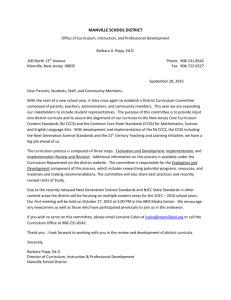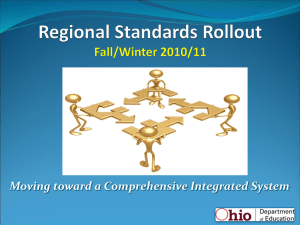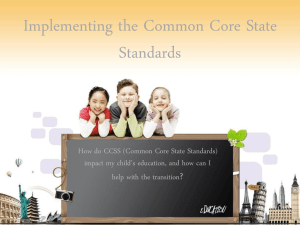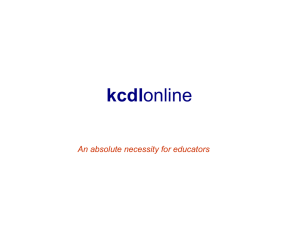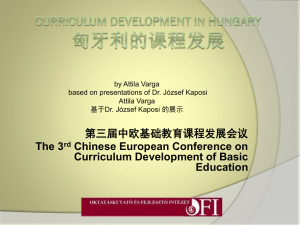Newly Revised Ohio Academic Content Science Standards
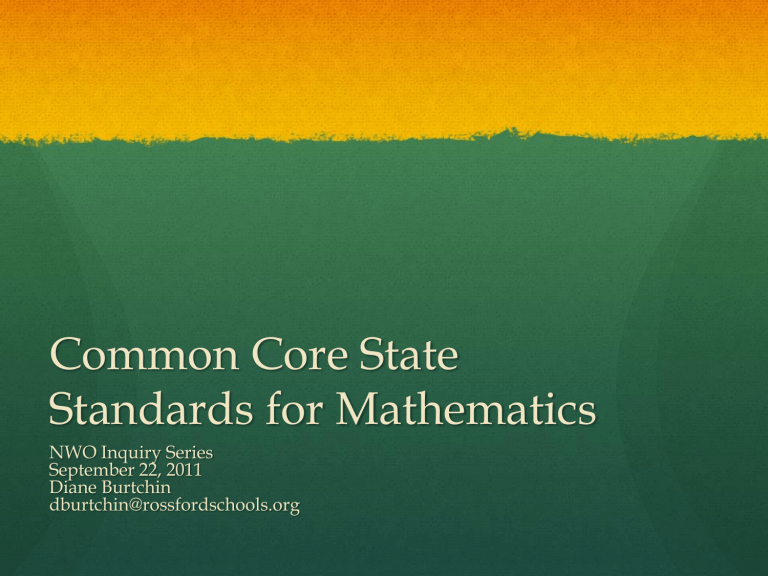
Common Core State
Standards for Mathematics
NWO Inquiry Series
September 22, 2011
Diane Burtchin dburtchin@rossfordschools.org
Why are you here??
Share with your neighbor:
The grade level/subject(s) you teach
Why you chose to come to this session
What you are hoping to take away from this session
What we will do tonight:
Watch a portion of a webinar on the CCSS for Mathematics
Discuss the Mathematical Practices
Explore the organization and content of the CCSS
Explore the organization and components of the Model
Curriculum
Explore the Learning Progressions and Critical Areas for K-
8 Mathematics
Discuss steps to take in order to ‘Start Smart’
Wrap up and preview of the next session
What?
Common
Core and
State
Revised
Standards:
June 2010
Model
Curricula:
March 2011
Aligned
System of
Assessments:
2014-15
How Well?
How?
Standards Adoption June 2010
English Language Arts
Mathematics
Science
Social Studies
Common Core
Standards
State Standards
5
CCSS Principles
Focus
Identifies key ideas, understandings and skills for each grade or course
Stresses deep learning, which means applying concepts and skills within the same grade or course
Coherence
Articulates a progression of topics across grades and connects to other topics
Vertical growth that reflects the nature of the discipline
CCSS Mathematical Practices
1. Make sense of problems and persevere in solving them
2. Reason abstractly and quantitatively
3. Construct viable arguments and critique the reasoning of others
4. Model with mathematics
5. Use appropriate tools strategically
6. Attend to precision
7. Look for and make use of structure
8. Look for and express regularity in repeated reasoning
Common Core Webinar
www.corestandards.org
The overview for Math can be viewed from 27:50-
52:11 on the webinar and is presented by the lead writer for the Mathematics CCSS (Bill McCallum)
CCSS Framework
Major units or areas of study
Domain
Main focus of the content statements
Cluster
What students should know
Standards
9
Format of K-8 Standards
Grade Level
Domain
Cluster
Standard
Standards for High School Math
Domain
Cluster
Standard
Advanced
CCSS for High School
Mathematics
Organized in “Conceptual Categories”
Number and Quantity
Algebra
Functions
Modeling
Geometry
Statistics and Probability
Conceptual categories are not courses
Additional mathematics for advanced courses indicated by (+)
Standards with connections to modeling indicated by ( ★ )
Now you try
You can find the CCSS by going to www.corestandards.org.
Download and navigate through the documents to find the grade level/subject area that you currently teach
Discuss: What are the differences between the
2002 standards and the newly revised standards? What is the same?
But wait…there is more..
Standards are the stopping point of the
2002 documents
HB1 mandated that a model curricula accompany the revised standards
MODEL CURRICULUM
One piece of an integrated whole
What?
Common
Core and
State
Revised
Standards:
June 2010
Model
Curricula:
March 2011
Aligned
System of
Assessments:
2014-15
How Well?
What is the Model Curriculum?
A web-based tool, aligned to the standards, that:
Presents information specific to the content area by grade level, grade band and course
Provides curricular and instructional guidance
Informs assessment development
16
Take a look…
Model Curriculum at ODE website (and on your desktop)
http://www.education.ohio.gov/GD/Templates/P ages/ODE/ODEDetail.aspx?page=3&TopicRelation
ID=1704&ContentID=83475&Content=112058
Model Curriculum Components
Content Elaborations:
In-depth information about “ what ” should be taught
Expectations for Learning/Visions into
Practice:
Recommendations for how students may demonstrate their learning
18
Model Curriculum Components
Instructional Strategies and Resources:
Guidance and support for instructional and curricular design
Content Specific Sections:
Address elements specific to a subject area
Common Misconceptions
19
Now you try
Use the Model Curriculum for your grade (or choose a grade) to list 3 things that the Model
Curriculum provides for teachers.
Discuss: What are the strengths of the Model
Curriculum? What are the limitations?
Learning Progressions &
Critical Areas
Refer to your handouts on both the K-8 Learning
Progressions and the K-8 Critical Areas
We begin with the “big picture”
CCSS Domain Progression
K
Counting &
Cardinality
1 2 3 4 5
Number and Operations in Base Ten
Number and Operations –
Fractions
Operations and Algebraic Thinking
Measurement and Data
Geometry
6 7 8 HS
Ratios and Proportional
Relationships
The Number System
Number &
Quantity
Expressions and Equations Algebra
Functions Functions
Statistics and Probability
Geometry
Statistics &
Probability
Flows Leading to Algebra
Standards Progression:
Number and Operations in Base Ten
Say Something
Look over the Learning Progressions
(handout) and underline topics or sections that you find interesting
Turn to an elbow partner and Say
Something about one of the phrases that you underlined…explain why you thought it was significant
Critical Areas
Refer to your handout for the K-8 Critical Areas
Note that Critical Areas are discussed in the
Introduction for each grade level/conceptual categories
Discuss in a small group how this information might guide your instructional decisions
2014
2011
Start Smart
2002
Standards
i t i s o a n r
T n
2010
Standards
Too Slow, Too Fast, Too
Little
Too
Slow
Too
Fast
Too
Little
Mistake
Ignore the standards…maybe they will go away!
Problem
2 nd grade—1 st to take 5 th grade test
5 th grade—1 st to take 8 th grade test
6 th and 7 th grade—1 st to take End of
Course HS exams
Really…how much has the new edition changed???
Adopt new resources that are ‘aligned’ to the newly revised standards
Checklist the standards, shuffle units from one grade level to another, and continue as is
• New Assessments will have Multiple
Choice, SA/ER, Computer Enhanced, and Performance Items
• Not only new content, but new ways of assessing = new instructional requirements
What can be done Short Term?
• Become familiar with the CCSS and model curriculum
• Use the Comparative Analysis or Crosswalks to highlight areas to emphasize, de-emphasize, drop, or modify (when available)
• Try some of the model curriculum Instructional Strategies that align with what is currently being taught
• Teach math with a focus on the Mathematical Practices
Comparative
Analysis
Grade 3
Content that is no longer a focus at Grade 3
Decimals – The initial study of decimals begins in grade four.
Measurement: Temperature/degrees, and other specific units of measure are a focus in grade four.
Three-dimensional geometry is not a focus in grade three.
Transformations, and especially symmetry, are introduced in fourth grade.
Volume is studied in grade five.
Data Analysis is a tool used to organize and analyze information from other domains
(geometry, measurement) and that utilizes the numbers and operations that are being studied. The initial formal statistical process and statistical analysis is moved to sixth grade.
Probability – The study of probability is a focus in grade seven.
Content continued with modifications at Grade 3
Multiplication/division: fluency of facts 9 x 9
Place value of numbers (through 1000)
Continued at this grade with modifications to the level of knowledge or expectation
Fractions: the content is the same with a focus on justifying equivalence, comparisons and other solutions using area models, number lines or knowledge about equal numerators or equal denominators.
Measurement: the focus is on standard units, developing a sense of measuring, estimating and problem solving using standard units of measure not on specific metric or US units.
Two-dimensional shapes, especially quadrilaterals, are explored and categorized by their attributes beginning a sense of a classification. Learning specific terminology is not the goal, the awareness of the different kinds of shapes and their attributes is.
Algebra topics are embedded within the study of numbers and their operations. Patterns are found in place value and arithmetic. Equations are written to model problems, including using unknowns but not necessarily with variables.
New content at Grade 3
Strategies, properties of operations and the relationship of operations are fundamental understandings to be demonstrated prior to fluency with algorithms when solving arithmetic problems. The expectation is that the properties of operations are used as a means of flexibly working with numbers, not necessarily identified by name. Algorithms for addition and subtraction are encountered naturally in third grade, but fluency with their use is not expected until fourth grade.
Multiplication is developed through the understanding of equal sized groups, arrays and area models. Connections are made to finding area in geometric measurement and to equal areas in fractions. Division is an outgrowth of multiplication based upon its inverse relationship. So finding a solution to a division problem is looking for the missing factor. Place value understandings are the foundation for multiplying by multiples of 10.
CCSS Support Materials
Mathematics Common Core State Standards and
Model Curriculum
Crosswalks: Cluster to Benchmark comparison
Learning Progressions View
K-8 Critical Areas of Focus
What should districts be doing?
FAQ
Model Curriculum
Preparation for Revised Standards
Tasks for Districts
2010-2011 2011-2012 2012-2013 2013-2014
• Introduce revised standards
• Participate in creating model curricula
• Build awareness of revised standards
• Introduce model curricula
• Conduct crosswalk activities
• Initiate formative instruction PD
• Begin integrating standards and curricula into district curricula and teachers’ course planning
• Introduce performance tasks and scoring rubrics
• Continue formative instruction PD
• Practice online formative assessments
• Introduce instructional improvement system
• Continue integrating standards and curricula into district curricula and teachers’ course planning
• Fully integrate standards and curricula into district curricula and teachers’ course planning
• Integrate performance tasks in course activities
• Prepare for online testing
• Complete formative instruction PD
34
Long Term Suggestions
Implementation matters--
Adoption of standards, programs, or textbooks merely opens the door
Time to consider, construct, collaborate, etc.
High-quality professional development should--
Focus on the content the teachers are teaching
Focus on the ways students are being instructed
Draw on curricular materials teachers are using
Involve constructing formative assessments and analyzing student work
Take the necessary time…Pay it Forward
Preview of Next Month
Assessment of the Common Core State Standards
What can we learn from the Model Curriculum to uncover how students will be assessed within the new system?
What types of questions will the students encounter within the new system?
How can we prepare students for the increased expectations of the new assessments?
Aligned System of Assessment
What?
Common
Core and
State
Revised
Standards:
June 2010
Model
Curricula:
March 2011
Aligned
System of
Assessments:
2014-15
Assessment Timeline
State Board Adopts
Standards
June, 2010
State Board
Adopts Model
Curriculum
March, 2011
Transition:
• Test development
• Field Testing
• Standards Setting
2012 - 2014
First
Assessment
Administration
2014-2015
2011 2012 2013 2014 2015
